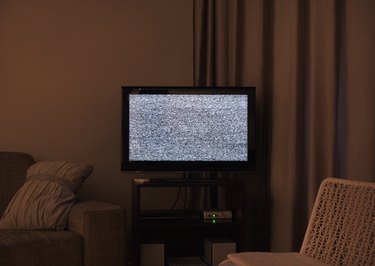
One of the most frustrating things that can happen to a DirecTV user is to suddenly and unexpectedly have your transponder signal lost in the middle of your favorite show or movie. Your receiver instantly transforms from a user-friendly and powerful entertainment source to a frustrating and useless little box. Fortunately, there a number of straightforward steps you can take to troubleshoot a no-signal issue. Once you understand the common causes of signal loss and know how to fix them, the dreaded DirectTV "no signal" error message will be much less intimidating.
What Is Rain Fade?
Video of the Day
A phenomenon called "rain fade" is one common cause of DirecTV signal loss. Rain fade happens when atmospheric conditions disrupt communication between DirecTV's broadcasting network and your home receiver.
Video of the Day
Although it's called rain fade, weather patterns may adversely affect your reception even if it's not actually raining at your home. Naturally, rain fade affects some regions of the country more than others. For instance, it is more common in the mid-western U.S., particularly during the rainy months, but is quite rare in the arid southwest.
Unfortunately, there isn't a great deal that can be done to prevent rain fade. Depending on your location, adjusting the angle of your satellite dish may help reduce incidences of the problem. In addition, switching out your dish for a larger, higher gain unit may help. You should consult with a local DirecTV technician before proceeding with either of these measures, as their effectiveness will depend on your specific location and other unique circumstances.
Identifying Unsubscribed Channels
Unsubscribed channels are a common source of confusion for DirecTV subscribers, particularly those who are new to the service. These are simply channels that DirecTV offers, but that are not part of your current programming package. They can be identified by their "grayed-out" appearance in the on-screen channel list.
Unsubscribed channels are not a problem and are not related to the strength of your DirecTV signal. They are displayed by default in order to preview additional options that you could add to your programming subscription. If you'd like to hide all unsubscribed channels, though, that's easy to do.
First, press the "GUIDE" button on your DirecTV remote. Then, press the yellow button on your remote to bring up the Guide Options menu. Next, select "Change Favorites List" and then select "Channels I Get." From now on, only the channels you are currently subscribed to will be displayed.
Testing Signal Strength
In order to verify that signal loss is what's actually causing your DirecTV system to stop working, it is helpful to run a signal strength test. This DirectTV troubleshooting test will return a numerical value – from zero to 100 – that represents the signal strength of each DirecTV satellite that your receiver is in communication with.
To run the test, press the "MENU" button on your remote control. Select "Parental, Fav's & Setup" from the on-screen menu. Next, select "System Setup." From there, go to Satellite and then select "View Signal Strength." The next screen will show a list of each satellite transponder and its current signal strength. It may take few seconds for all of the readings to show up.
Note that there will probably be a number of transponders that show zero signal strength. This is normal and no cause for concern. Each subscriber only needs to be connected to a small number of the company's satellites in order to receive a fully functional signal. As long as you see at least a few transponders with readings near 100, you should be fine.
Resetting Your DirecTV Receiver
While it won't always fix the problem, particularly if rain fade is to blame, resetting your receiver is a good thing to try when you're stuck with a DirectTV "no signal" error message. It forces your DirecTV system to run through its start up procedure and reconnect to the satellite network. If your signal issue was related to a software glitch of some sort, resetting it will often be enough to return the receiver to its normal, functioning state.
There are two easy ways to reset your receiver. The first is to press and hold the small red "RESET" button located behind the access card door on the front panel of the receiver. You can also reset your receiver via the on-screen menu. To begin, press the "MENU" button on your remote. Select "Parental, Fav's & Setup." Next, select "System Setup". Finally, select "Reset."
It is important to note that, following a reset, future-date program information may be temporarily affected. Keep this in mind when planning to watch or record specific programming.